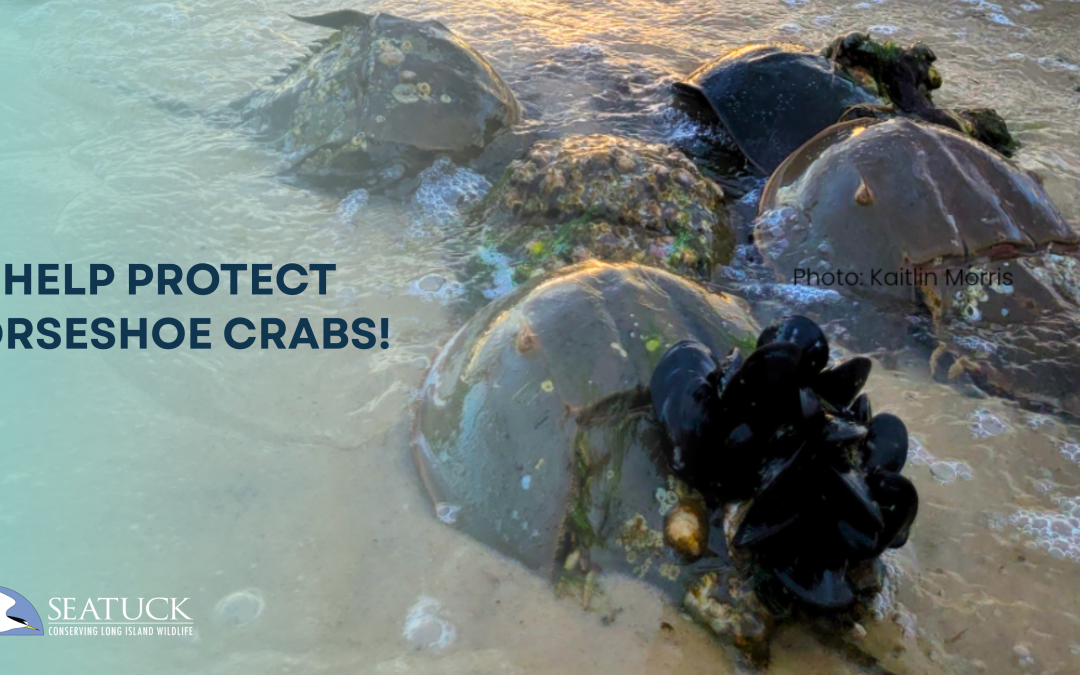Protect an Ancient Mariner & Help Preserve the Great South Bay
Every spring, as the full and new moons rise over the shores of Long Island, one of the most extraordinary natural events in the region unfolds. Under the moonlight, horseshoe crabs—prehistoric creatures that have existed for over 450 million years—emerge from the sea to spawn along the beaches of New York’s Marine District, including critical habitats around the Great South Bay.
These moonlit migrations are not just a spectacle—they’re a vital part of the coastal ecosystem. And this year, like every year, we need your help to make sure this ancient ritual continues for generations to come.
We’re proud to support our colleagues at the Seatuck Environmental Association in the annual New York State Department of Environmental Conservation’s (NYSDEC) Horseshoe Crab Monitoring Program, a community science initiative that gives volunteers of all backgrounds the opportunity to get involved in meaningful environmental stewardship—right here on the South Shore.
Why Horseshoe Crabs Matter to the Great South Bay
While they may look like creatures from a different planet, horseshoe crabs are actually a keystone species in our local marine ecosystem. Their nutrient-rich eggs provide critical food for migratory shorebirds like the red knot, which travels thousands of miles and depends on these eggs to refuel. Without healthy horseshoe crab populations, bird species and other marine life face serious ecological consequences.
In the Great South Bay, the presence of horseshoe crabs also indicates the health and biodiversity of our estuarine environment. Monitoring their populations helps us understand broader changes in the bay, such as water quality, habitat loss, and the impacts of climate change. In short, protecting horseshoe crabs means protecting the Great South Bay itself.
A Citizen Science Effort with Real Impact
Since 2009, the NYSDEC Horseshoe Crab Monitoring Program has engaged hundreds of volunteers in collecting scientific data on horseshoe crab spawning activity.
This data is essential. It helps the NYSDEC assess the status of horseshoe crabs in New York’s Marine District and informs conservation decisions made by the Atlantic States Marine Fisheries Commission, which manages horseshoe crab populations along the East Coast.
By volunteering, you’ll take part in a genuine scientific survey that gathers data on:
- Spawning abundance (how many crabs are mating)
- Size and sex ratios
- Tag returns (to help track movements and population trends)
This work is especially important as horseshoe crabs face increasing pressure from habitat degradation, harvesting for bait, and biomedical use. Community engagement in data collection is a powerful tool in advocating for better protections and sustainable management.
What to Expect as a Volunteer
Local surveys are conducted at Captree State Park on full and new moon evenings in June, when spawning activity peaks. Each site has a trained coordinator who will guide volunteers in how to properly count, measure, and record data.
No prior experience is necessary—just a willingness to learn and a respect for wildlife.
Once you register, you’ll receive instructions on how to prepare, what to bring (flashlight, clipboard, waterproof footwear), and how to connect with your site coordinator. Taking the time to understand the protocol in advance helps the survey run safely and effectively, and deepens your learning about horseshoe crab biology and conservation.
An Educational Experience for All Ages
This is more than just data collection—it’s a chance to engage in hands-on environmental education. You’ll learn about:
- Horseshoe crab anatomy and life cycle
- Their unique ecological and medical importance
- The role of community science in conservation policy
It’s also a fantastic opportunity for students, teachers, families, and nature lovers to connect with Long Island’s natural heritage. Kids often find the creatures fascinating (and a little alien), and the night-time beach setting makes it a truly memorable experience.
How to Get Involved
📅 Survey Dates: Full and new moon evenings in June
📍 Locations: Captree State Park
🧭 Guidance: Provided by trained site coordinators
📝 Registration: Required prior to participating
👉 Sign up now to volunteer at Captree: Horseshoe Crab Monitoring Program
Whether you volunteer once or every survey night, your time and attention make a difference. You’re helping protect a species that has survived five mass extinctions, and you’re contributing to the long-term resilience of the Great South Bay—one crab at a time.
Stewardship Starts With Us
At Save The Great South Bay, we believe that community action is the backbone of local conservation. Our colleagues at Seatuck share this philosophy, and this collaborative effort exemplifies what’s possible when science, stewardship, and public engagement come together.
So grab a headlamp, gather your curiosity, and join us on the beach. Let’s ensure the Great South Bay—and its ancient mariners—have a bright, sustainable future.


I live on the Grand Canal/ Connetquot River.If my wife and I can be of assistance, we are willing to help.
My professional career, spanning nearly 50 years, was teaching and consulting marine engineering operation and design.